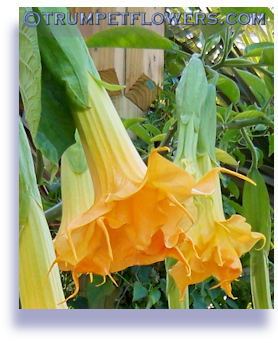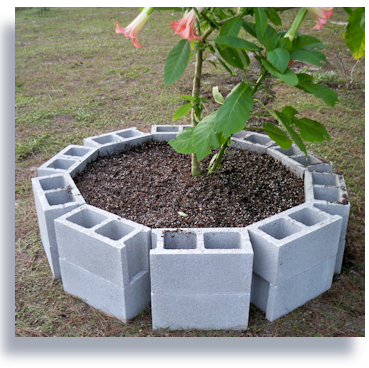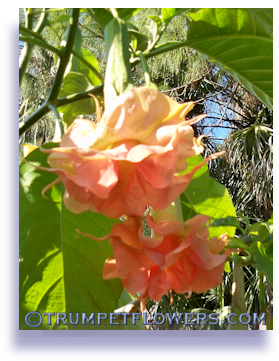DIY Raised Garden
Bed
I am still writing this page, thanks :)
 Florida is notorious for poor soil. To get around this, building your own raised garden beds are a fantastic way to not only
give your plants their optimum growing capacity, but also create something quite lovely for your yard at a cheap price, using the right materials.
Florida is notorious for poor soil. To get around this, building your own raised garden beds are a fantastic way to not only
give your plants their optimum growing capacity, but also create something quite lovely for your yard at a cheap price, using the right materials.
Because this raised garden bed will hold a brugmansia, we decided to make it about 4 feet across. That's the interior measurement, the outer full diameter is about 5 1/2 feet. It is 16 inches tall. This gives the angel trumpet plenty of room to spread her roots, and will give me a very large, tree sized brugmansia in the future. I used an already large sized brugmansia, that had been sitting in a 20 gallon pot, Pink Dragon.
To start, you'll need some materials.
- 20 concrete cinder blocks
- ** bags concrete, no gravel added
- 10 Wood boards, approx. 6 inches wide by 16 inches tall
- Two ** long pieces of nylon cord
For finish, (not yet pictured) you will need:
- 3 sheets 1/2 inch thick, 4 X 8 styrofoam
- ** tubes Liquid Nails
- ** bag concrete, no gravel
- ** Concrete Paint (kind you add into mix)
- bucket for water
- trowel, small
- sponge
For the soiless mix, we used:
- 11 bags very good, well rotted compost
- 1 ∼ 3 cubic feet bag of peat
- 1 ∼ 2 cubic bag of perlite
- 1 ∼ 10 pound bag of osmocote
- optional: 8 bags lavarock, river stone, etc.
- Wheelbarrow, shovel, rake, garden hose
 Step 1: Find a good area in your yard for the 5 to 6 foot diameter raised bed. Make sure the spot is level. Begin laying out the bottom 10 concrete blocks until they form a circle. Make the inner edges of the block kiss as closely as you can. Continue shaping the circle, eyeballing it, until it is the way you like it. The spacing between the blocks on the outer rim ended up being between 5 and 6 inches on ours. Now stack the second tier on top of the first.
Step 1: Find a good area in your yard for the 5 to 6 foot diameter raised bed. Make sure the spot is level. Begin laying out the bottom 10 concrete blocks until they form a circle. Make the inner edges of the block kiss as closely as you can. Continue shaping the circle, eyeballing it, until it is the way you like it. The spacing between the blocks on the outer rim ended up being between 5 and 6 inches on ours. Now stack the second tier on top of the first.
Step 2: Begin making your mix for the soiless mix. Open 2 bags compost and dump into wheelbarrow. Cut open the side of the bag of peat and remove entire top so you can shovel it out. Add 6 heaping shovel fulls of peat for each 2 bags compost. Add 6 shovels perlite to the wheelbarrow. Add 8 to 10 measures of osmocote to the top (large bags of osomocote come with a small measuring cup inside bag).
Mix all of this together well with your shovel, turning and digging into the mixture until it is completely blended.
Step 3: Now you can either gently remove 2 sets (4 blocks) of the cinder blocks and wheel in the first two to three loads of mix and dump it at far end of the inner circle of the raised bed, or shovel the soilless mix in. After about 3 dumps, you will have to replace the blocks, but we found it easier on our backs and faster to remove blocks and then replace.
Step 4: Continue filling with mixture until it is gone. The last mix will be only one bag of compost and the remaining perlite and peat. Rake it to smooth.
Step 5: Now comes the brugmansia or other small tree you plan on placing out in the rasied bed. Mine was Pink Dragon, in a 22 gallon container. Have the plant and pot beside the now built raised bed and eyeball the width across the top of the pot. In the center of the raised bed, use your shovel to dig out the right sized hole for the brugmansia to sit in. Leave the removed mixture in the raised bed. We had to go almost to the bottom of our soilless mix for depth.
Step 6: Remove the brugmansia from the planter by banging on the sides of the pot and bottom. Two people are nice to have at this point, one to hold the plant, the other to lift it out. If the plant is root bound, take a hand saw to all sides and the bottom of it, removing any curled roots on bottom. You only have to remove about an inch on the sides. This will make for a bigger tree. Place it into the hole.
Step 7: Rake lightly all of the soil to a level surface. Now water it very well. This can take 10 to 15 minutes, as the peat was dry and it's hard to get it to hold water at first. Water until you see water running out of the bottom between the cinder blocks.
Step 8: You can top it off with river rock, lava stone or mulch if you like. We used lava stone, as it helps keep pests down, including any cats that might think of it as a giant litter box.
Finishing the Sides of the Raised Bed
Step 1:
Tags: diy raised garden bed, raised garden bed, do it yourself, raised bed for brugmansia, cheap raised garden bed, brugmansia, angel trumpet raised bed,



